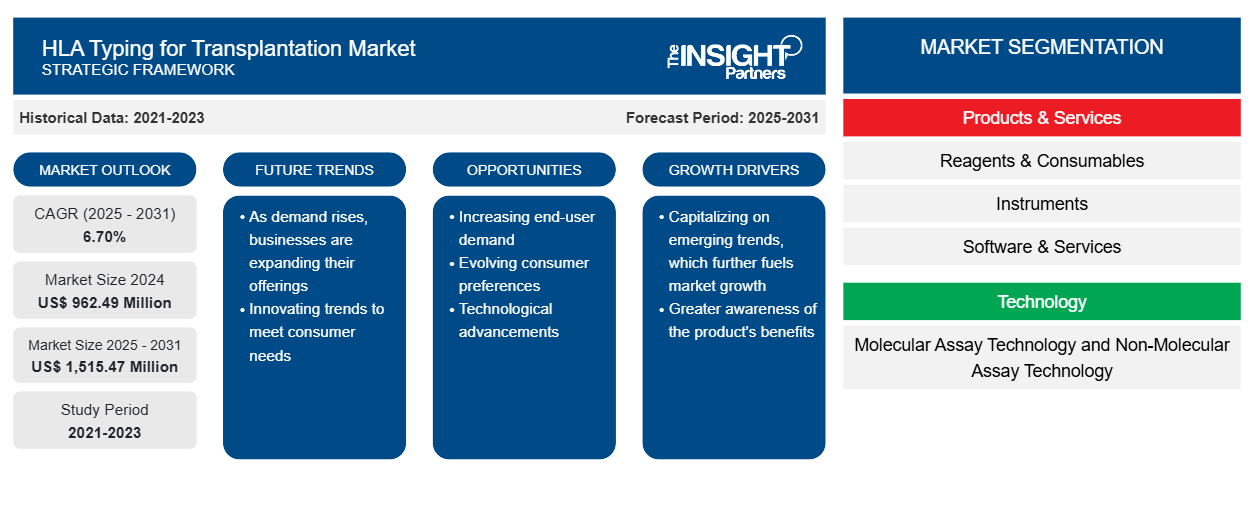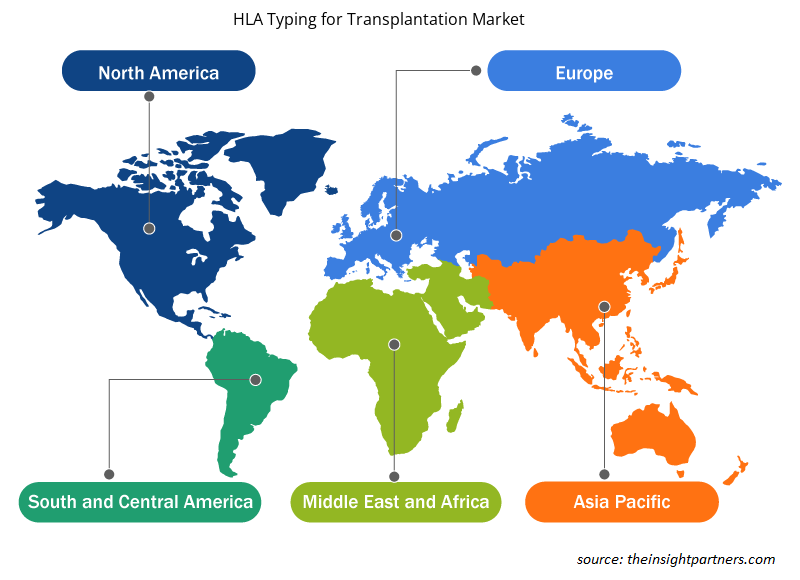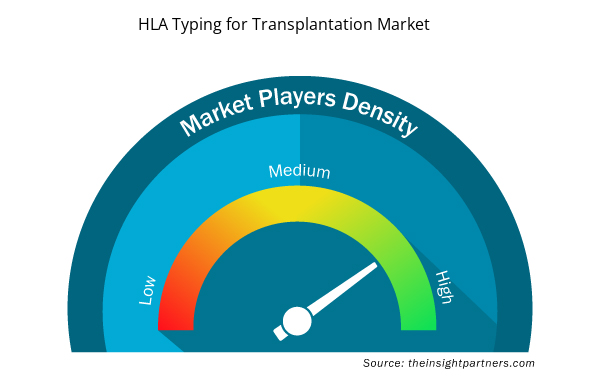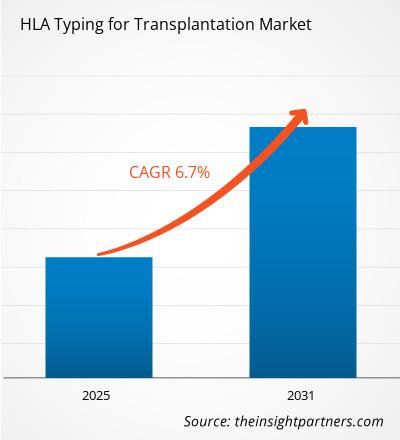[Research Report] The HLA typing for transplantation market size was valued at US$ 845.41 million in 2022 and is projected to reach US$ 1,420.20 million by 2031. It is expected to register a CAGR of 6.7% in 2022-2031.
Market Insights and Analyst View:
HLA Typing for Transplantation is a type of procedure that is used to match patients' and donors' organs to be transplanted so that there is less reaction in the patient’s body. A close match between a patient’s and donor’s HLA markers is important for an effective transplant outcome. Also, HLA matching promotes the development of new healthy blood cells (called engraftment) and reduces the risk of a post-transplant complication called graft-versus-host (GVHD) disease.
Growth Drivers:
There has been a constant increase in organ failure incidence across the globe due to various chronic health conditions such as genetic disorders, cardiovascular disorders, and diabetes. As per the Health Resources and Service Administration report 2021, 106,247 people, including women, men, and children, are on the US transplant waiting list. Every 9 minutes, a person is added to the transplant list in the US. Thus, the increasing incidence of organ failure is responsible for the demand of organ transplant procedures, which drives the growth of the organ care products industry.
Over the past few decades, organ donation has increased, increasing awareness among people and rapidly developing health facilities globally. As per the Global Observatory on Donation and Transplantation, globally, ~129,681 organ transplantations were performed in 2021. Additionally, the surge in government initiatives to create health awareness has increased the donor registry and the number of living donors for kidney and liver. As per the Health Resources and Service Administration report 2021, about 22,800 kidney transplantations have been performed in the US in 2021, which accounts for ~83% of the total transplant procedures in the US. In addition, developing healthcare facilities and introducing technologically developed products to enhance the success rates of transplant procedures and decrease organ rejection rates has augmented the organ transplantation procedures, contributing to the growth of HLA typing for transplantation markets.
Organ transplantation is a combination of practical and technical practice. Its success depends on surgical expertise, immunobiology, and therapeutics, which help reduce organ rejection. It requires well-developed healthcare facilities and expert surgeons to complete the entire procedure efficiently. The entire process is resource-intensive, including various tests, pricey drugs, and high-paid doctors, which adds up the transplant procedure cost. For instance, in the US, the average cost of a kidney transplant was approximately US$ 442,500 in 2021, including pre-and post-transplant care, hospital changes, organ procurement, and medicines.
On the other hand, various cultural beliefs have impacted organ donation, including myths, Confucianism, traditional beliefs of being buried whole, and cultural misunderstanding. Apart from cultural beliefs, bodily mutilation, altruism, and lack of understanding about organ donation are likely to hamper organ donation, restraining the growth of the HLA typing for transplantation market.
Customize This Report To Suit Your Requirement
You will get customization on any report - free of charge - including parts of this report, or country-level analysis, Excel Data pack, as well as avail great offers and discounts for start-ups & universities
HLA Typing for Transplantation Market: Strategic Insights

- Get Top Key Market Trends of this report.This FREE sample will include data analysis, ranging from market trends to estimates and forecasts.
Customize This Report To Suit Your Requirement
You will get customization on any report - free of charge - including parts of this report, or country-level analysis, Excel Data pack, as well as avail great offers and discounts for start-ups & universities
HLA Typing for Transplantation Market: Strategic Insights

- Get Top Key Market Trends of this report.This FREE sample will include data analysis, ranging from market trends to estimates and forecasts.
Report Segmentation and Scope:
The “Global HLA Typing for Transplantation Market” segmentation is done on the basis of products & services, transplantation type, technology application, end user, and geography. Based on products & services, the HLA typing for transplantation market is segmented into reagents & consumables, instruments, software & services. Based on technology, the HLA typing for transplantation market is bifurcated into molecular assay technology and non-molecular assay technology. Molecular assay technology is further segmented into PCR-based assay technology and sequencing-based assay technology. Non-molecular assay technology is further subsegmented into serological assay and mixed lymphocyte culture assay. Based on application, the HLA typing for transplantation market is segmented into diagnostic and research. Based on transplant type, the HLA typing for transplantation market is segmented into solid organ transplant and soft tissue transplant. Based on end users, the HLA typing for transplantation market is segmented into independent reference laboratories, hospitals & transplant centers, and research laboratories & academic laboratories.
The HLA typing for transplantation market based on geography is segmented into North America (US, Canada, and Mexico), Europe (Germany, France, Italy, UK, Russia, and the Rest of Europe), Asia Pacific (Australia, China, Japan, India, South Korea, and the Rest of Asia Pacific), Middle East & Africa (South Africa, Saudi Arabia, UAE, and the Rest of Middle East & Africa), and South & Central America (Brazil, Argentina, and the Rest of South & Central America).
Segmental Analysis:
Based on products & services, the HLA typing for transplantation market is segmented into reagents & consumables, instruments, software & services. In 2022, the reagents and consumables segment held the largest market share of the HLA typing for the transplantation market. Moreover, the same segment is expected to grow at the highest CAGR during the forecast period HLA typing for the transplantation market. Reagents and Consumables are anticipated to grow as researchers focus on developing reagents that provide accurate results, optimize testing strategies, and reduce costs and time associated with traditional experiments.
The kits and consumables segment is growing due to the presence of a large number of manufacturers such as Abbott, F. Hoffmann-La Roche Ltd, and Bio-Rad Laboratories, Inc. Further, in response to the growing cases of transplantation and shortages of laboratory-based molecular testing capacity and reagents, multiple testing manufacturers have developed and begun selling consumables that reduce a time for analysis. Moreover, kits and reagents are frequently used in various research processes, and there is a constant rise in product launches. Hence, owing to the presence of the various market players that are offering multiple reagents & consumables and the rise in technological advancements, the segment is expected to grow during the forecast period.
Based on technology, the HLA typing for transplantation market is bifurcated into molecular assay technology and non-molecular assay technology. Molecular assay technology is further segmented into PCR-based assay technology and sequencing-based assay technology. Non-molecular assay technology is further subsegmented into serological assay and mixed lymphocyte culture assay. In 2022, the molecular assay technology segment held the largest market share of the HLA typing for transplantation market. Moreover, the same segment is expected to grow at the highest CAGR during the forecast period HLA typing for transplantation market.
Based on application, the HLA typing for transplantation market is segmented into diagnostic and research. In 2022, the diagnostic segment held the largest market share of the HLA typing for transplantation market.
Based on transplant type, the HLA typing for transplantation market is segmented into solid organ transplant and soft tissue transplant. In 2022, the solid organ transplant segment held the largest market share of the HLA typing for transplantation market. Moreover, the same segment is expected to grow at the highest CAGR during the forecast period HLA typing for transplantation market.
Based on end users, the HLA typing for transplantation market is segmented into independent reference laboratories, hospitals & transplant centers, and research laboratories & academic laboratories. In 2022, the hospitals & transplant centers segment held the largest market share of the HLA typing for transplantation market.
Regional Analysis:
Based on geography, the HLA typing for transplantation market segments into five key regions: North America, Europe, Asia Pacific, South & Central America, and Middle East & Africa. In 2022, the North American HLA typing for transplantation market held the largest share of the HLA typing for transplantation market. The Asia Pacific HLA typing for transplantation market is anticipated to register the highest CAGR during the forecast period. The US HLA typing for transplantation market held the largest share in North American HLA typing for transplantation market. The increasing chronic kidney diseases and prevalence of the geriatric population in the US will accelerate the development of this market. For instance, according to the National Chronic Kidney Disease fact sheet, in 2021, approximately 30 million people had chronic kidney diseases in the US.
Furthermore, as per the National Institute of Diabetes and Digestive and Kidney Diseases, about 661,000 Americans have kidney failure, out of which 468,000 patients are undergoing dialysis, and 193,000 have undergone kidney transplantation. In addition, according to CDC, Chronic Kidney Disease (CKD) is more frequent in people aged 65 years or older (38%) than in people aged 45–64 years (12%) or 18–44 years (6%) with respect to the current estimate. Moreover, with the increasing prevalence of CKD in the US, CKD-related health problems worsen over time. It also increases the chances of having heart disease and stroke. Thus, owing to these facts, the cases of kidney transplantations are likely to increase in the coming years.
Moreover, rising FDA approvals and the presence of major market players in the region are boosting the market. In 2021, heart disease was responsible for the maximum number of deaths in Mexico. According to the National Statistics Institute, in the first eight months of 2021, 141,873 deaths were recorded by heart disease and 99,733 deaths by diabetes. Malignant tumors were fourth. Influenza and pneumonia were the fifth-most common cause, with 29,573 deaths. These factors induced organ donation, specifically heart, lung, and kidney donation. Moreover, rapidly advancing healthcare infrastructure is also aiding in successful organ transplantation, resulting in increasing growth of HLA typing for transplantation market in the region.
Industry Developments and Future Opportunities:
Various initiatives taken by key players operating in the global HLA typing for transplantation market are listed below:
- In December 2022, FDA granted de novo classification to the SeCore CDx HLA Sequencing System for use as a companion diagnostic with Kimmtrak for metastatic or unresectable uveal melanoma.
- In September 2021, Thermo Fisher Scientific announced two new additions to its transplant diagnostics portfolio at the American Society for Histocompatibility and Immunogenetics (ASHI). These new products will enable transplant laboratories to characterize samples better and enhance their speed and reliability to the transplant laboratory.
Competitive Landscape and Key Companies:
Some of the HLA typing for transplantation market leaders are Thermo Fisher Scientific, Illumina, Qiagen, Care DX, Roche Sequencing Solutions, Bio-Rad Laboratories, Immucor Inc, Omixon Inc, Abbott Laboratories. And GenDx. These companies focus on product launches and expansions geographically to meet the increasing consumer demand worldwide and increase their product range in specialty portfolios. These companies have a widespread global presence, which provides them to serve a large set of customers and subsequently increase their market share. The report offers a trend analysis of the HLA typing for transplantation market, emphasizing on various parameters such as market dynamics, technological advancements, and competitive landscape analysis of leading market players across the globe.
Report ScopeHLA Typing for Transplantation Market Regional Insights
The regional trends and factors influencing the HLA Typing for Transplantation Market throughout the forecast period have been thoroughly explained by the analysts at Insight Partners. This section also discusses HLA Typing for Transplantation Market segments and geography across North America, Europe, Asia Pacific, Middle East and Africa, and South and Central America.

- Get the Regional Specific Data for HLA Typing for Transplantation Market
HLA Typing for Transplantation Market Report Scope
| Report Attribute | Details |
|---|---|
| Market size in 2024 | US$ 962.49 Million |
| Market Size by 2031 | US$ 1,515.47 Million |
| Global CAGR (2025 - 2031) | 6.70% |
| Historical Data | 2021-2023 |
| Forecast period | 2025-2031 |
| Segments Covered |
By Products & Services
|
| Regions and Countries Covered | North America
|
| Market leaders and key company profiles |
HLA Typing for Transplantation Market Players Density: Understanding Its Impact on Business Dynamics
The HLA Typing for Transplantation Market market is growing rapidly, driven by increasing end-user demand due to factors such as evolving consumer preferences, technological advancements, and greater awareness of the product's benefits. As demand rises, businesses are expanding their offerings, innovating to meet consumer needs, and capitalizing on emerging trends, which further fuels market growth.
Market players density refers to the distribution of firms or companies operating within a particular market or industry. It indicates how many competitors (market players) are present in a given market space relative to its size or total market value.
Major Companies operating in the HLA Typing for Transplantation Market are:
- Thermo Fisher Scientific
- Illumina
- Qiagen
- Care DX
- Roche Sequencing Solutions
Disclaimer: The companies listed above are not ranked in any particular order.

- Get the HLA Typing for Transplantation Market top key players overview
- Historical Analysis (2 Years), Base Year, Forecast (7 Years) with CAGR
- PEST and SWOT Analysis
- Market Size Value / Volume - Global, Regional, Country
- Industry and Competitive Landscape
- Excel Dataset



Report Coverage
Revenue forecast, Company Analysis, Industry landscape, Growth factors, and Trends

Segment Covered
Products & Services, Technology, Application, Transplant Type, End Users, and Geography

Regional Scope
North America, Europe, Asia Pacific, Middle East & Africa, South & Central America

Country Scope
This text is related
to country scope.
Trends and growth analysis reports related to Life Sciences : READ MORE..
- Thermo Fisher Scientific
- Illumina
- Qiagen
- Care DX
- Roche Sequencing Solutions
- Bio-Rad Laboratories
- Immucor Inc
- Omixon Inc
- Abbott Laboratories
- GenDx

 Get Free Sample For
Get Free Sample For